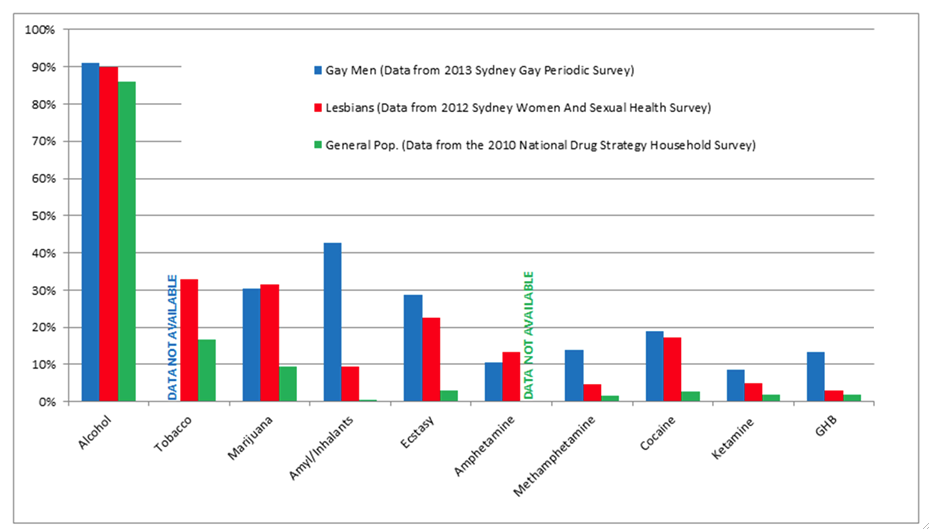
Sex, drugs and taking control
RECENT data is bringing into sharper focus how people in our community are using alcohol and other drugs (AOD) – and the results are causing concern for LGBTI health advocates.
ACON, NSW’s leading HIV and LGBTI health organisation, has been involved in addressing AOD use for many years.
From supplying sterile injecting equipment, to providing counselling and support services, to promoting education campaigns and running volunteer programs like the ACON Rovers, ACON’s approach is all about working with people in a supportive and non-judgemental way to help reduce the harms associated with AOD use.
While the use of alcohol and illicit drugs in the general population is well researched, it’s only in the past few years that newly collected data has started to paint a clearer picture of AOD use in the LGBTI community.
“There’s not a lot of comparative data as we’ve historically been left out of general population studies,” ACON Acting Chief Executive Karen Price said.
“And the limited data we do have focuses on lesbian, gay and bisexual (LGB) people, with transgender and intersex people largely excluded — an issue we’re seeking to address.
“But what the data we do have tells us is that AOD use among LGB people is basically much higher than the general population across most types of drugs.” (see graph below)

NB: Drug use is often measured in different ways in different surveys. In the SGPS and SWASH, drug use refers to the proportion of participants who reported use in the previous six months. In the NDSHS, drug use refers to the estimated prevalence of use in the previous 12 months.
In terms of illicit drugs, research shows that gay and bisexual men report significantly higher rates of use for most substances when compared to the general population, especially amyl nitrate, methamphetamine and GHB.
Lesbians and same-sex attracted women report significantly higher use for marijuana and amphetamines. Ecstasy and cocaine are also used by gay men and lesbians at much higher rates than the general community.
While the rates of use of alcohol are only slightly higher than the general population, rates of risky drinking are higher among LGB people, especially among women.
Dr Toby Lea from the Centre for Social Research in Health at the University of NSW explained that there were two schools of thought about why the LGBT community presents with these disproportionately high statistics on AOD use.
The first theory suggests AOD use may be a coping mechanism for people perceiving and experiencing LGBTI-related stigma.
The second line of thought argues AOD use is “normalised” in LGB social networks and in the scene.
“Historically, the social world of LGBT people has been largely situated in the bars and nightclubs of the scene,” Lea said.
“As bars and clubs — gay or straight — are common settings for AOD use, it is perhaps unsurprising that AOD use is often considered to be a central feature of LGBTI sociality, and regular engagement with the scene may increase opportunities for AOD use.”
While the rates of use of all drugs are higher, not all results in significant harm.
However, there are also many people who experience a range of problems – physical, mental, social, economic and legal – as a result of their AOD use.
Many LGBTI people know of someone in their friendship circle who fits this description – and the numbers are increasing.
In a 2012 report about AOD use in the LGB communities, the National Drug and Alcohol Research Centre (NDARC) described not only elevated rates of illicit drug use, but more importantly, also the need for more specific and targeted interventions for the community.
“We know that specific sub-populations, particularly those who experience significantly higher rates of stigma, discrimination and marginalisation, are over-represented amongst those who develop more regular and harmful drug use patterns,” NDARC’s Professor Alison Ritter said.
“We also know that targeted and specific programs are required for these populations.
“Demand exceeds supply across drug and alcohol services generally, and the absence of any specific programmatic focus on the LGB communities is a very obvious gap.”
“People experiencing harm ought not to have to reach extreme levels of harm before they can access help.
“Evidence based tools exist for screening, brief intervention, and referral into treatment, and could prove very useful, particularly if combined with some peer expertise, and offered in a non-judgmental service setting.”
It’s a view echoed by Karen Price.
“The increasing use of stimulants in our society, especially methamphetamine, is causing considerable concern in the wider community, due to the negative health impacts of these drugs,” she said.
“We know people in our community are concerned and some are seeking help.
“However, despite the evidence of substantially higher AOD use in our community, there is a lack of appropriate treatment and support services that are available for people seeking help.
“Due to the much higher use of stimulants and other drugs by LGB people, the case is compelling for additional resources to be made available to meet the corresponding demand for treatment and support.
“That makes a lot of sense when you look at the return on investment from treatment — it’s not only good health policy, but it’s got strong economic merit for relevant government agencies.”
Price added there needed to be an increase in the capacity of stimulant treatment programs, such as the one at St Vincent’s Hospital in Darlinghurst.
“St Vincent’s service is an effective harm reduction focussed support program, but as one of the only programs of its kind in Australia, the service is currently at capacity,” she said.
“For people who make the critical decision that they’re ready to address their problematic AOD use, it’s important to ensure that they have timely access to relevant support services, an expectation that would no doubt be shared by their family and friends.”
Increasing the capacity of stimulant treatment programs is one of the key objectives contained in a new strategy from ACON that aims to tackle AOD use in NSW’s LGBTI community.
“Our five-year strategy is a comprehensive and long term vision which seeks to bring relevant service providers together through a harm reduction approach to address problematic drug use and risky drinking in our community,” Price said.
“In terms of putting the plan into action, we’ll be continuing our advocacy efforts, seeking out modest funding to support some ACON service delivery, and utilising our community volunteers to run a number of support services for LGBTI people around AOD use.”
Price said the LGBTI-focussed AOD support programs that are provided by ACON — both for individuals and groups — play a vital role in helping community members address problematic drug use.
“As communities that have been, and continue to be, stigmatised, it’s not surprising that some LGBTI people are reluctant to seek help in some mainstream settings.
“Also, problematic AOD use among LGBT people often has some very specific cultural context so having services provided by organisations like ACON, which are sensitive to LGBTI issues, is crucial.”
Increasing awareness of AOD issues through community education initiatives is another key objective of the new plan.
“Friendship networks in the LGBTI community have historically been a huge source of support for people facing problematic AOD use,” Price said.
“In fact recent research has shown LGB people are more likely than the general population to have concerns about friends’ drug use, and to think about where to refer them.
“I guess you could say there’s more of a ‘culture of care’ and that’s a strength.
“ACON’s view is that we are best placed to have a conversation with our community – to raise awareness, provide some tips on early intervention and work with concerned community members to facilitate appropriate interventions with lovers, friends or family.
“It’s about tackling this subject in a supportive and open way that encourages people to make choices in their best interests.”
The strategy also highlights the need for health promotion messages that address the interaction between AOD use and risky behaviours relating to the transmission of HIV and other STIs.
As part of the strategy, ACON will also be advocating to ensure AOD research and policy development includes LGBTI people, and that existing services in the AOD sector are catering to LGBTI people.
As for a take-home message, for Price, it’s all about community.
“LGBTI people have a proud history of looking after each other, and this issue is no different,” she said.
“By working together, peer-to-peer, we can deal with these sensitive issues and provide the support that many people in our community so urgently need.”
The ACON Alcohol and Other Drugs Strategy 2013-18 can be downloaded from the ACON website: www.acon.org.au
ACON also recently released a strategy addressing the use of tobacco in the LGBTI community. It can also be downloaded from the ACON website.










It’s truly a great and helpful pijece of info. I am satisfied that you shared
tyis helpful information with us. Please keep us up to date like
this. Thank you for sharing.
As the admin of this web page is working, no doubt very soon it will be famous, due tto its quality
contents.
Wow that was strange. I just wrote an extremely
long comment but aftr I clicked submit my coomment didn’t show up.
Grrrr… well I’m not writing all that over again. Regardless, just wanted to say fantastic blog!
I’m not sure where you’re getting your info, but great topic.
I needs to spend some time learning much more or understanding more.
Thanks for excellent info I was looking for this information for my mission.
I think the admin of this site is actually working hard in support
of his web site, because here every stuff is quality based stuff.